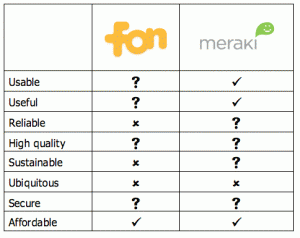
 Canadian researcher, Catherine Middleton, has published a paper entitled “Is it Good to Share? A Case Study of FON and Meraki Approaches to Broadband Provision.” It is available in PDF format and the presentation is also downloadable.
Canadian researcher, Catherine Middleton, has published a paper entitled “Is it Good to Share? A Case Study of FON and Meraki Approaches to Broadband Provision.” It is available in PDF format and the presentation is also downloadable.
What FON and Meraki have in common is that they are both consumer-deployed infrastructure and both trade on the benefit of network effects. The paper presents a useful analysis of both organisations but strains a bit in making an effective comparision between them because the models are so different. FON is a distribution network of “Foneros” who share their Internet connections via WiFi in exchange for gaining low-cost access to other Fonero access points. Thus FON access points can be anywhere there is an Internet connection. Meraki on the other hand depends on nodes being connected to each other via a mesh network protocol. You can see how it is hard then to make a head-to-head comparison. I would be more interested in seeing a head-to-head comparison of Meraki and OpenMesh.
I still found the paper very useful, particularly in its analysis of FON. It points out the critical failing that FON doesn’t achieve anything like ubiquity in distribution and particularly availability of access points and consequently turn out to be not so useful to people who might want to take advantage of roaming access. The notion for driving around a city looking for a live FON access point can hardly be very appealing. It would be more interesting if FON were able to link up with a service like IPASS so that you could leverage access where you want it most in cafes and airports (well, those are my priority spots :-). However, it would probably be difficult to find a fit with IPASS’s purely commercial model. Anyway, the take home for me about FON was the importance of ubiquity. The paper rates Meraki a little higher than FON because it achieves “local ubiquity” which in the context of Meraki is probably as good as is needed.
Middleton argues that Meraki’s model, while more successful than FON’s, still suffers from a reliability issue because the infrastructure is dependent on the community. She highlights an incident with Meraki where a number of people turned off their routers in order to plug in Christmas trees causing the otherwise robust, redundant mesh network to fail. It highlights the fact that a Meraki user can’t be a simple consumer, they need to be a participant in the community. This may not be a bad thing. 🙂

However, Middleton’s final assessment is that both FON and Meraki are challenged when it comes to going to scale. She argues that there is a need for cental coordination that is not easily achieved through the ad-hoc nature of community efforts. This is something of a curious conclusion as the Internet itself is an ad-hoc network that succeeds very well. It may be that FON and Meraki are doomed precisely because they attempt to have centralised control over their networks. It may be that a federated model that links heterogenous community WiFi initiatives may be more successful; a situation in which an Île Sans Fil user in Montreal might have privileges on a FON or a Meraki network.
So what does this mean for the Village Telco? I think the Village Telco is likely to address the key sustainability issues that Middleton raises about these networks. I like the general criteria (pictured at left) that she comes up with to assess the networks. I think they will be useful benchmarks to keep in mind as the Village Telco evolves.